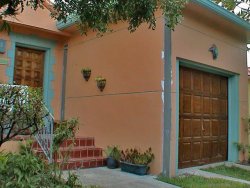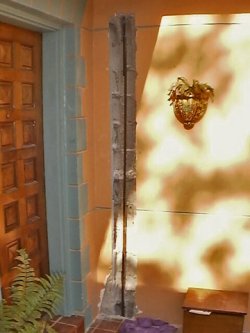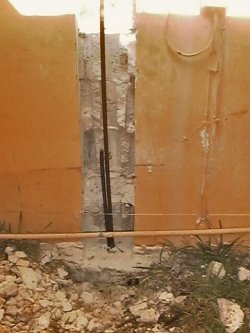|

|
Masonry walls with grey concrete grout filling sections of the wall where block was cut and steel has been added - The remaining steps include adding stucco and re-painting the walls.
(click image for larger version) |
|
As is common for most structural retrofits, it is much easier and cheaper to build in the strength when the home is first built than after it is completed. Un-reinforced masonry has not fared well in strong hurricanes. Most of the collapsed buildings in Hurricane Charley were un-reinforced masonry buildings. If the walls are tall or if the roof structure that is providing lateral support for the tops of the walls is damaged, un-reinforced masonry walls will collapse.
If you have a concrete masonry block home there are a couple of techniques for determining how well the exterior walls are reinforced and anchored to the foundation. If you have installed permanent anchors for shutter on your windows and found that the blocks on both sides of your windows are hollow, you probably have un-reinforced or at least under-reinforced walls and some additional checks would be a good idea.
In addition, just because a few holes you made indicated solid concrete does not mean that the blocks are necessarily reinforced with steel and concrete. It is possible that you hit a concrete partition within the concrete block. Some blocks have two cells so they have one interior partition of block that goes from front to back of the block while some blocks have three cells and have 2 partitions. Because concrete blocks are easier to drill into than solid concrete, you may be able to distinguish between the partitions of a block and solid concrete simply by how hard your drill has to work. Un-reinforced or under-reinforced means that the cells of blocks did not have steel placed in them and were not poured with concrete at corners and beside each door and window. If you have not installed permanent anchors for shutters, you can use a small masonry bit and drill holes in the wall on both sides of the window opening, in an inconspicuous location about 3-inches outside the line formed by the vertical edges of the window. In newer wind resistant construction, you should find solid concrete on one side or the other of the window. If you find hollow blocks on both sides, you probably have un-reinforced or at least under-reinforced walls and additional checks would be a good idea. You can patch your little exploratory holes using a little dab of exterior caulk after you have blown off the concrete dust.
There are some stud finders with metal detection that are capable of determining the location of reinforcing bars in masonry walls. Typically they have a "deep penetrating" metal detector option. Be sure to follow the manufacturer's instructions for calibration when you turn them on. These metal detectors can be used to conduct additional checks to determine how well your masonry walls are reinforced and anchored to the foundations. The checks outlined below are intended to help you make this determination. In older masonry homes, conventional practice was to grout "J" bolts into the top of the walls and anchor a wood plate to these "J" bolts. The trusses or rafters are then connected to this wood plate. In these walls, there may not be any reinforcing steel installed that runs from the top of the wall to the foundation. In some cases, the top blocks in the wall have a "U" shaped cutout and reinforcing steel is laid in that "U" shaped cradle and the top blocks are filled with concrete to form a bond beam at the top of the wall. In some cases, a header beam (also known as a lintel) installed above the window and door opening is the only part that is reinforced and no reinforcing is installed along the remainder of the top of the wall. To determine how well your wall is reinforced, use the deep penetrating metal detector setting on the stud finder / metal detector to search for steel in your walls. Some of the better metal detectors will also indicate if both metal and electricity are detected. Consequently, be careful that you don't pick up a false positive from an electrical cable. Also don't be confused when using a metal detector near metal from window frames or downspouts. Make an effort to distinguish between steel in the wall and other indications by trying to track the indication. Click on the Masonry Wall Checklist to get more information about inspecting your masonry walls and some suggestions about what the findings may mean to you.
Inspecting the Walls for Reinforcing:
Begin your search for reinforcing by checking for steel at the outside corners of the house. Go to an outside corner of your house and with the stud finder / metal detector in deep penetrate mode and placed against the wall about head high at the corner, move the stud finder sideways across the wall away from the corner. Repeat this on the other face of the corner. If you detect metal, move the stud finder vertically along a line that passes through the point where you detected the metal to make sure that the metal runs from the top of the wall to the bottom. Note the results on the Masonry Wall Checklist. Then check along the top of the walls to determine if there is reinforcing steel running along the top of the wall. Note: if the block wall extends one or more block heights above the soffit panels, you will not be able to check for this from the outside of your house without removing the soffit in the area where you want to make a test. If you do remove soffit do not be confused by the metal detector finding aluminum parts of the soffit system. Next, move the metal detector horizontally along the outside wall of the house, sliding it along over a long stretch of wall without openings to see if reinforcing bars are found. Determine the distance between the reinforcing, if any is detected, and note the results in the checklist below. Finally, check the location of anchor bolts or straps embedded in the masonry wall from the attic and estimate the distance of one of these from a corner of the house. Then go to that location on the outside of the wall and from a ladder determine how far down into the wall the metal is indicated. Most "J" hooks are about 16-inches long and will engage the top couple of blocks when they are grouted into the top of the wall. If you get an indication of metal running all the way down through the wall, then it is likely that the cell below the "J" hook contains reinforcing steel and that these cells have hopefully been fully grouted throughout the height of the wall. Note the results on the checklist.
Interpreting the Results:
What you want to find is steel in the top row of blocks, steel coming down the wall at least at corners and next to openings for doors and windows over 5' wide, and steel going down to the foundation. Older homes may have very little or no vertical reinforcing. The evolution of vertical reinforcing in masonry walls is from no vertical steel; to the use of steel in the outside corners; to adding steel at one or both sides of wide openings such as sliding glass doors or garage doors; to steel at one side of even more openings and occasionally interspersed along long walls; to today's standards of steel at every opening and regular spacing on all exterior walls.
If you did not find any indications of reinforcing steel in your walls (answered "no" to all of the wall questions on the Masonry Wall Checklist), you have un-reinforced masonry walls and, if your home faces a large open area or the water or your house is 30' or wider, your home may be at risk of wall collapse or losing its roof in a Category 2 or stronger hurricane. The least expensive thing you can do to reduce your risk of wall damage or loss of the roof is to protect all large windows and doors. You should make sure that your garage door is protected or replaced with an appropriate wind rated one if you don't already have one. Protecting your windows and doors could mean the difference between the home keeping its roof on or losing it when the winds climb above category 1 strength. You should definitely plan on evacuating if a category 2 or above storm is threatening your area, even if you protect the windows. You may want to consider adding reinforcing as described in the following sub-section when you undertake a major re-modeling job. If you decide to try and reinforce your walls, you should get a design professional to help you find the best solution for your house.
If you found steel in all the right places (answered "Yes" to all the Masonry Wall Checklist questions), you have reinforced masonry walls and you do not need to worry about retrofitting your walls. Just to be clear that you found steel at the top of the walls and down the full height of the walls at the corners and at wide openings.
If you found some steel at the corners but that was about it (answered "yes" to some but "no" to other questions), you probably have under-reinforced masonry walls. You should put a high priority on protecting all large windows and doors, including garage doors. You may also want to consider adding reinforcing as described in the following sub-section when you undertake a major re-modeling job. If you decide to try and reinforce your walls, you should get a design professional to help you find the best solution for your house.
Improving the Strength of Masonry Walls:
Reinforcing an existing masonry wall is probably the most difficult and expensive retrofit you might consider undertaking. The International Existing Building Code (Section 305.1) and the Florida Existing Building Code (Section 305.1), and perhaps other building codes require that the entire building has to be brought up to current building codes when remodeling work progresses past 50% of the building area within any 12-month period. The following description is for illustrative purposes only, if you are considering undertaking this type of retrofit, you should get a design professional to help you find the best solution for your house.
The technique we have seen used for adding reinforcing to an existing masonry wall house involves cutting out the face of the blocks in a vertical column at the wall corner, on one side of each window or door opening, and at a spacing of 4 to 8 feet along the wall when there is no opening. Steel reinforcing rods are then epoxy grouted into the bond beam at the top and the foundation with an overlap of at least 25 inches where they meet. The cells are then filled with grout and the wall finish re-applied. An idea that has been used in earthquake retrofits has been to install steel plates on the inside and outside of the walls that are tied together with bolts that pass through the wall and the two plates. The top bolt has to go through the bond beam at the top of the wall. A third idea that has been the subject of limited research is where a cutout is made at the top and bottom of the wall and a cable is fed through the cells in between the holes. The side of the block at the bond beam is also chipped out and a rod is epoxy grouted horizontally into the bond beam. The bottom of the cable is then formed into a loop with several cable ties and positioned in the middle of the cell. Grout is poured in through the top hole and once it begins to flow out of the bottom hole, the bottom hole is blocked and grout is added until it flows out of the top hole. The top of the cable is hooked around the rod in the bond beam and cable clamps are tightened so that the cable is pulled tightly around the rod. Grout is than added until both the top hole and the side of the bond beam are filled. This hole is then blocked and the grout is allowed to harden.

|
Masonry block cut out to allow steel reinforcing to be added - short pieces are epoxy grouted into the foundation and into the bond beam at the top of the wall.
(click image for larger version) |
|

|
Closer shot of bottom of reinforcing added to masonry wall showing the short segment epoxy grouted into the foundation and the rod added through the wall - Note that the two pieces have to overlap a significant distance so that the forces can be transferred down through the walls.
(click image for larger version) |
|
|

